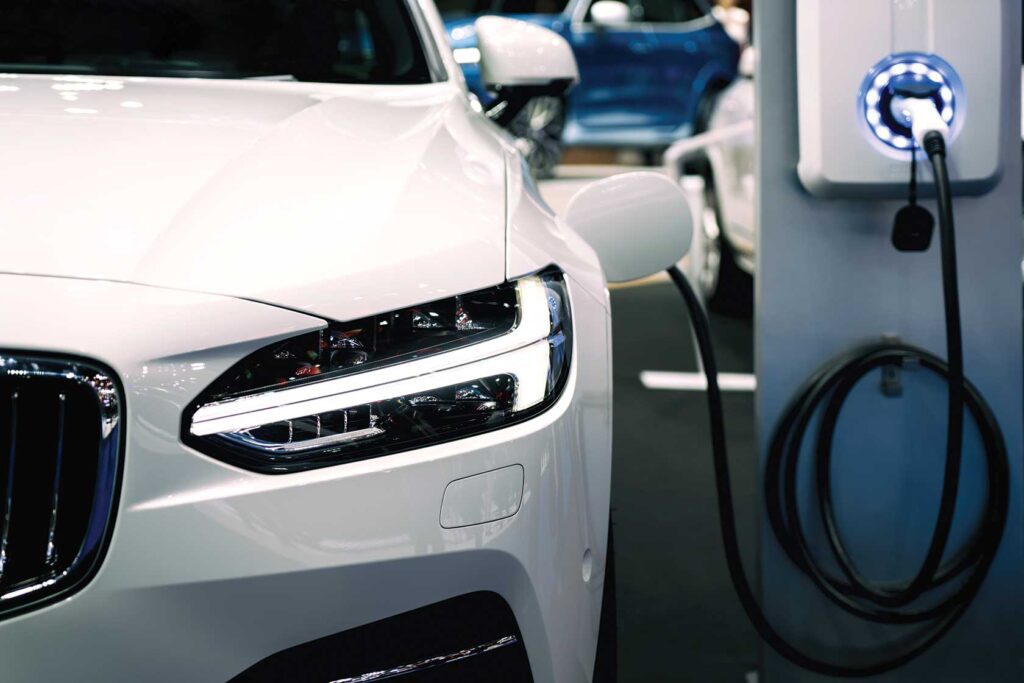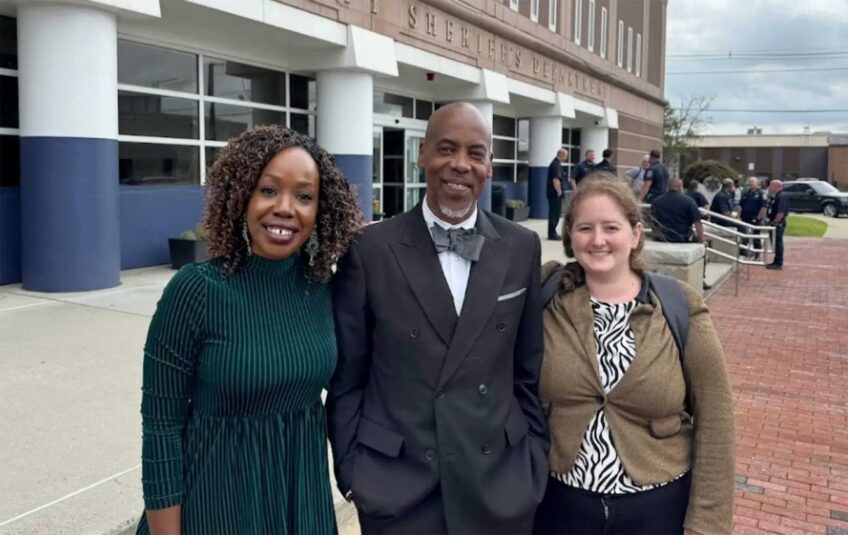City explores curbside electric vehicle charging stations in residential areas
Expanding into diverse neighborhoods a focus

Boston is exploring ways to add electric vehicle chargers curbside in neighborhoods to create greater access for residents who drive electric vehicles, but can’t charge them at home. The city’s current selection of chargers is installed in municipally owned parking lots.
“Across the country, the assumption is like, ‘Oh, most people will do all their charging at home in their driveway,’” said Oliver Sellers-Garcia, the city’s Green New Deal chief. “That works for most of the country, but it doesn’t work for dense, urban cities like Boston where we have so many people who drive and they don’t have an off-street parking place to charge their car.”

Oliver Sellers-Garcia, Boston’s Green New Deal chief, addresses attendees at the C40 Boston Transport Summit July 11. PHOTO: AVERY BLEICHFELD
Although whites appear to buy most electric vehicles, new research suggests significant percentages of Black, Latino and Asian American drivers are interested in abandoning gasoline-powered vehicles. Sellers-Garcia says expanding charging stations into diverse neighborhoods is a focus of the city effort.
Having the ability to charge at or near home is an important piece of making it possible for people to rely on electric vehicles as their only car, said Jessika Trancik, an MIT researcher who published a paper in 2021 investigating the placement of the chargers.
Trancik and her fellow researchers found residential charging overnight can satisfy electric vehicle drivers’ needs most days.
“When you look at how people drive throughout the day, and day to day, and throughout the year, and how that varies across different individuals, for most people upwards of 95% of days — even for the lower cost electric vehicles [which tend to have a lower range] that are on the market — they wouldn’t have to recharge during the day,” she said.
Under two requests for proposals released in late June, the city would pursue adding curbside chargers in residential neighborhoods under two models. Under one, the chargers would be owned and operated by the city. The other seeks a partnership with a private operator that would manage the chargers at no cost to the city but pay no fees to install them in a public right-of-way.
As part of the plans, Sellers-Garcia said the city is focusing on installing chargers in environmental justice communities, a qualification defined by the state based on income, percentage of minorities in the community and ability to speak English.
Research has documented a desire for electric vehicles among populations of color. A national survey released in September by Consumer Reports along with EVNoire, a group focused on vehicle electrification at the intersection of diversity, equity and inclusion, and GreenLatinos, an organization focused on climate change, found that 33% of whites would definitely or seriously consider buying an electric vehicle, while 38% of Blacks, 43% of Latinos and 52% of Asian Americans would consider purchasing one.
But that desire isn’t reflected in statistics of who buys electric vehicles. A 2018 report from the National Center for Sustainable Transportation, looking at car sales in California between 2011 and 2015, found that white drivers made up over half of electric vehicle and plug-in hybrid sales compared to about 40% of non-electric, internal combustion engine car sales. In contrast, Latino drivers made up 10% of electric vehicle sales and Black drivers made up 2% — compared to 38% and 3% of sales of gas-powered vehicles, respectively.
Sellers-Garcia said the city’s goal of placing chargers in environmental justice communities is, in part, trying to preemptively address a growing demand in those communities. With tax incentives, as well as a Massachusetts law that says no new internal combustion engine vehicles can be sold in the state after 2035, he anticipates more purchases in all neighborhoods.
“We’re trying to get ahead of what we know will be demand,” Sellers-Garcia said. “I think that means distributing them in in all neighborhoods, whether we’re solving for the use case of someone who is ready to buy a car now or we’re getting ahead in a use case where we know that this is coming and we’re looking to meet a need before it becomes, yet again, another investment that is not distributed equitably.”
Sellers-Garcia said the city is also using this opportunity, now, to look ahead toward other plans around electric vehicles. While these initial requests for proposals would install a limited number of chargers, Sellers-Garcia said they give the city the opportunity to explore options — like whether the publicly-owned or the public/private partnership model works better for the city — while federal funding under initiatives like the Charging and Fueling Grant Program in the Bipartisan Infrastructure Law is still available.
“We’re really doing this to serve a need and we hope people use them and get immediate value out of them,” Sellers-Garcia said. “But it’s a productive experiment, right? We’re looking to see what we can learn, and if and how we scale those things up.”
Alone, a shift to electric cars won’t fully address greenhouse gas emissions. A February report released by Polestar and Rivian — two electric vehicle manufacturers — found that even an “aggressive battery electric vehicle adoption” and a full switch to fossil-free power sources wouldn’t fully address the problem of greenhouse gas emissions.
For the city of Boston, that means focusing not just on electrifying personal vehicles, but prioritizing getting people out of cars and into other modes of transportation.
On July 11, Mayor Michelle Wu kicked off the Boston Transport Summit, which brought together municipal leaders from across the United States and Canada alongside local transit and environmental advocates to discuss how to not only increase use of electric vehicles, but also improve things like public transit, bike shares and biking infrastructure.
In her keynote address, Wu cited city data that found almost a third of Boston’s carbon emissions came from transportation.
“If we’re serious about delivering a Green New Deal for cities, we must tackle the biggest contributors to the problem head on,” she said. “In the most immediate sense, transportation has an enormous impact on our quality of life. For many of us, it’s a service we rely on daily, one that impacts our health and mobility, our sense of freedom, and overall happiness.”
Wu also said that this moment requires working together to successfully address transportation needs and climate change.
“We have an opportunity today to not only keep our planet livable, but to make life better, healthier, more enjoyable for all of us along the way,” she said. “What’s good for our environment is also good for our communities.”







